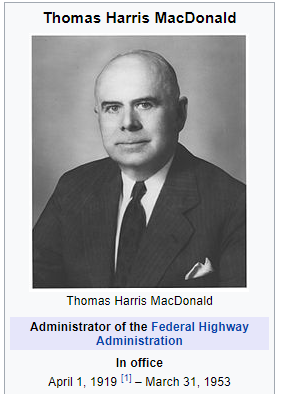Federal Highway administration

The Trailblazers
No history of road construction in the United States can be complete without an acknowledgment of the difficult pioneering work performed by engineers of the U.S. Bureau of Public Roads (now called Federal Highway Administration [FHWA]) in the early days of direct Federal construction on national forest and park lands. The men who located, designed, and built the initial highways in the Federal domain, often under adverse conditions, completed important links and extensions that were essential in the development of the Nation's highway systems.
Read More
Thomas H. Macdonald
Thomas H. MacDonald, who headed the U.S. Bureau of Public Roads (BPR) from 1919 to 1953, is a towering figure in the history of highways. He helped to revitalize the Federal-aid highway program by initiating a system focus, with emphasis on roads that were “interstate in character,” in the Federal Highway Act of 1921. By the time he left office, he has ushered the Nation to the brink of the Interstate era. During these years, he was recognized as the greatest authority on highway development and a man of unquestioned integrity and commitment.
Read More
Highway History
The Federal Highway Administration (FHWA) and its predecessor agencies have been directly engaged in the location, design, and construction of public roads, giving access to and through the National Parks, the National Forests, and other areas within the Federal domain since 1905. The record of intergovernmental cooperation with the other agencies concerned has been outstanding to this day. In 1905, the same year of the U.S. Forest Service was established, the Division of Tests of the Bureau of Chemistry and the Office of Public Road Inquiries in the U.S. Department of Agriculture were consolidated into the Office of Public Roads. In spite of extremely limited staff and resources, immediate plans were made to offer a professional service in the area of road construction to other agencies of the Federal Government. This work was essentially advisory in nature. The Federal-Aid Road Act, approved July 11, 1916, is historic as it established the basis for the Federal-Aid highway program in cooperation with the States. To carry out the provisions of the Act, a complete Federal highway engineering organization was needed throughout the country. In 1917 10 districts were established, with each district given the responsibility for the construction of rural Post Roads in cooperation with the State highway departments, and for the survey, construction, and maintenance of National Forest roads in cooperation with the U.S. Forest Service and the State and local authorities. The Agricultural Appropriation Acts of 1912 and 1913 provided funds that could be expended on construction of roads and trails serving the National Forest, and for the first time offered a sustained source of revenue for road improvement purposes in the public domain.
Read More